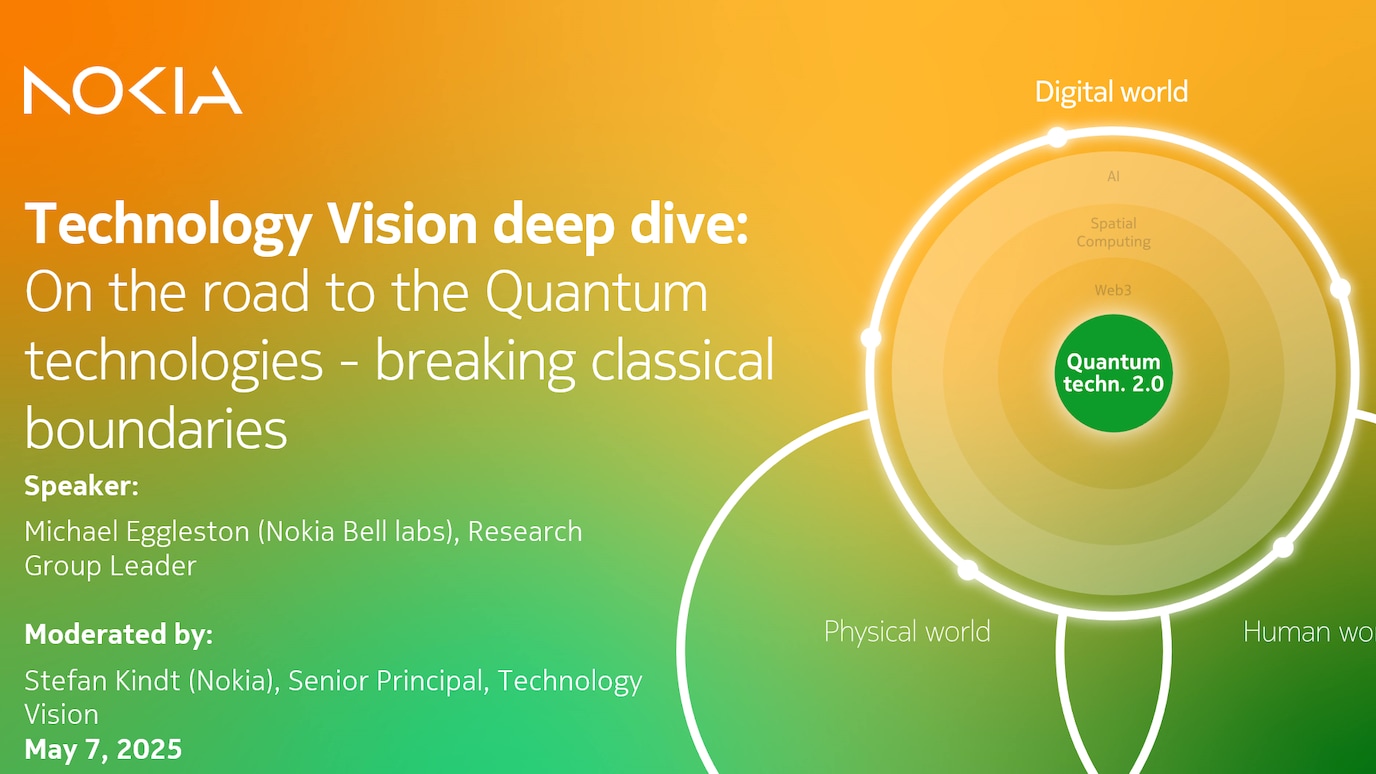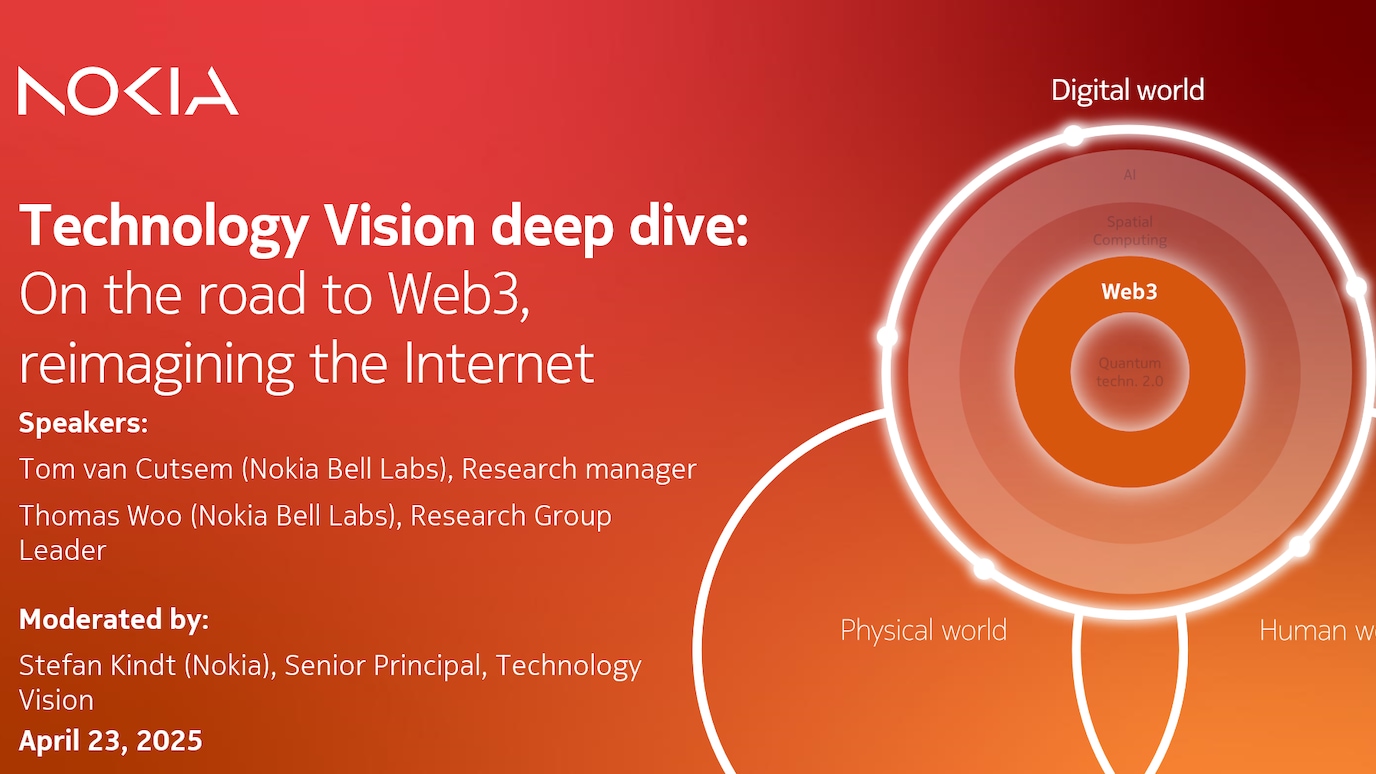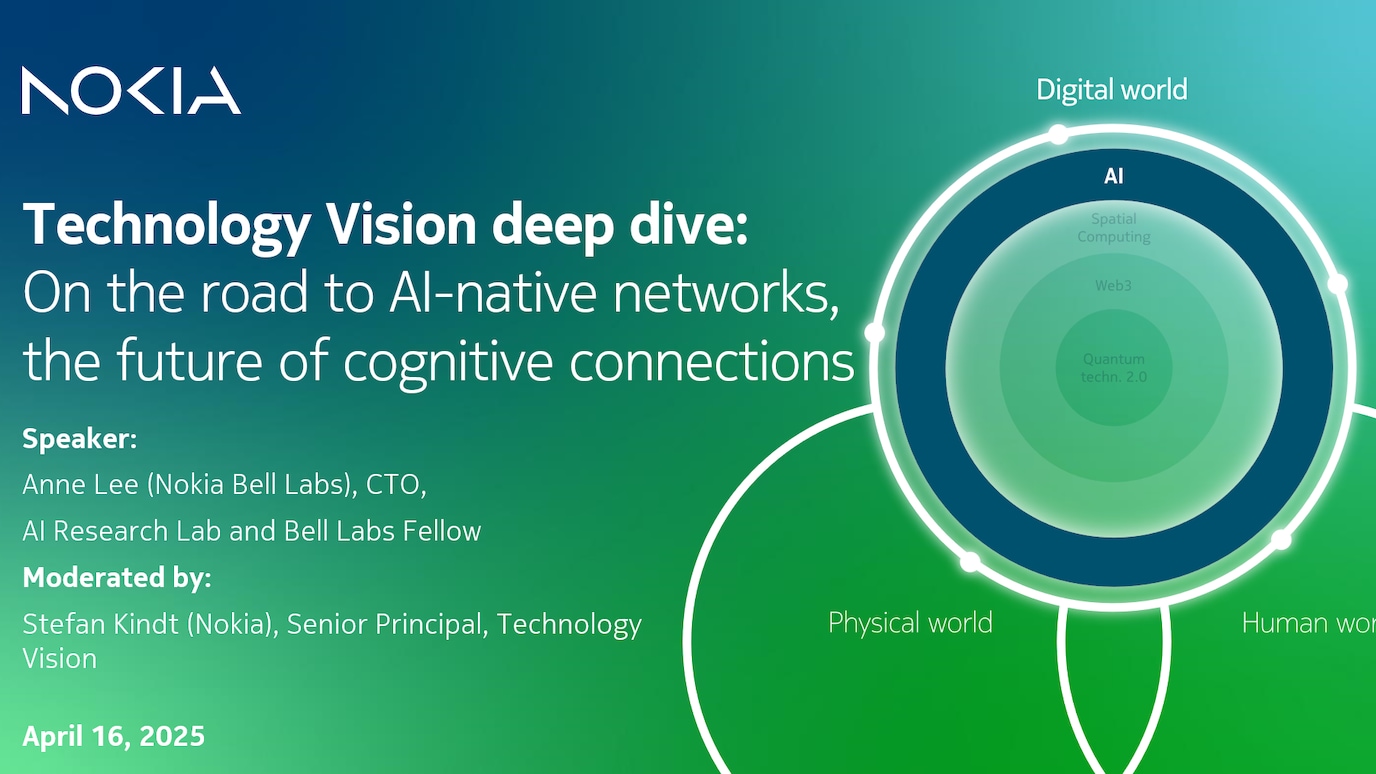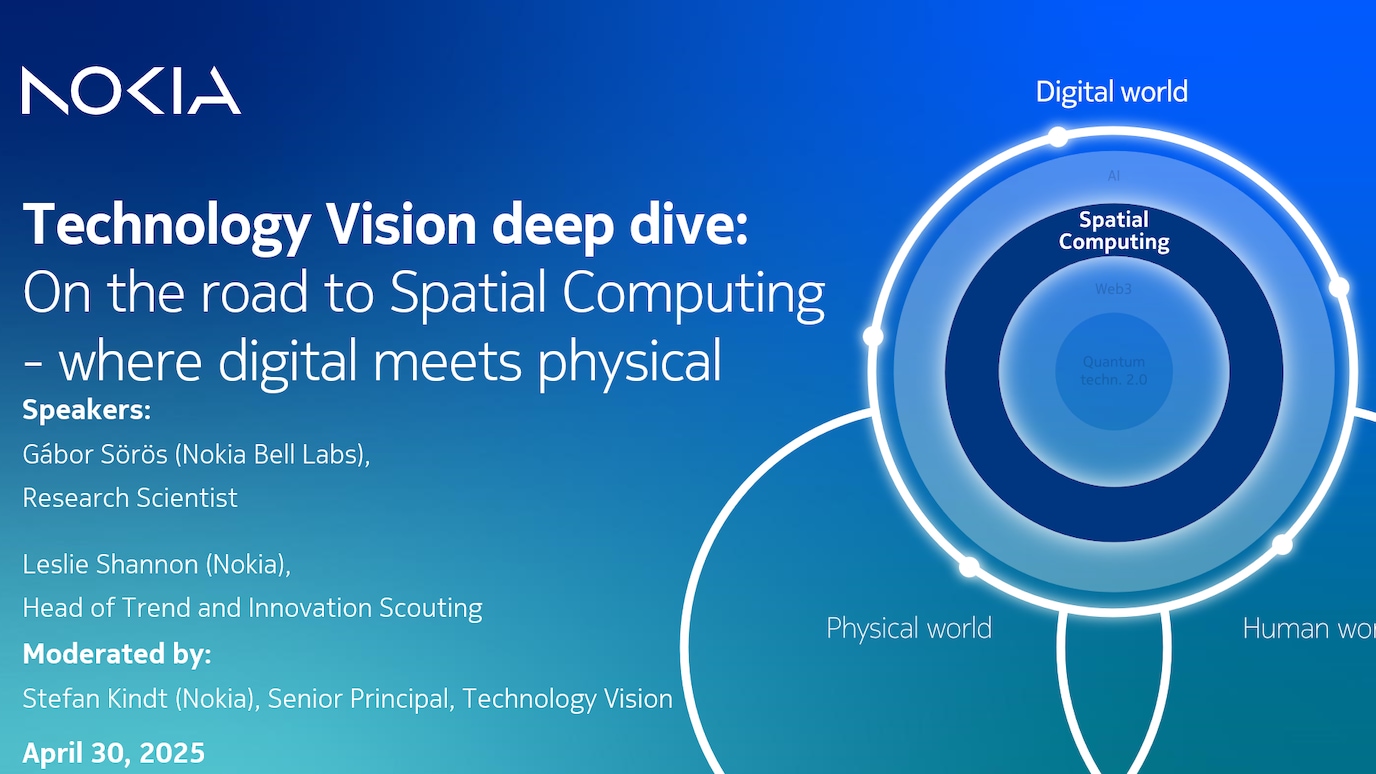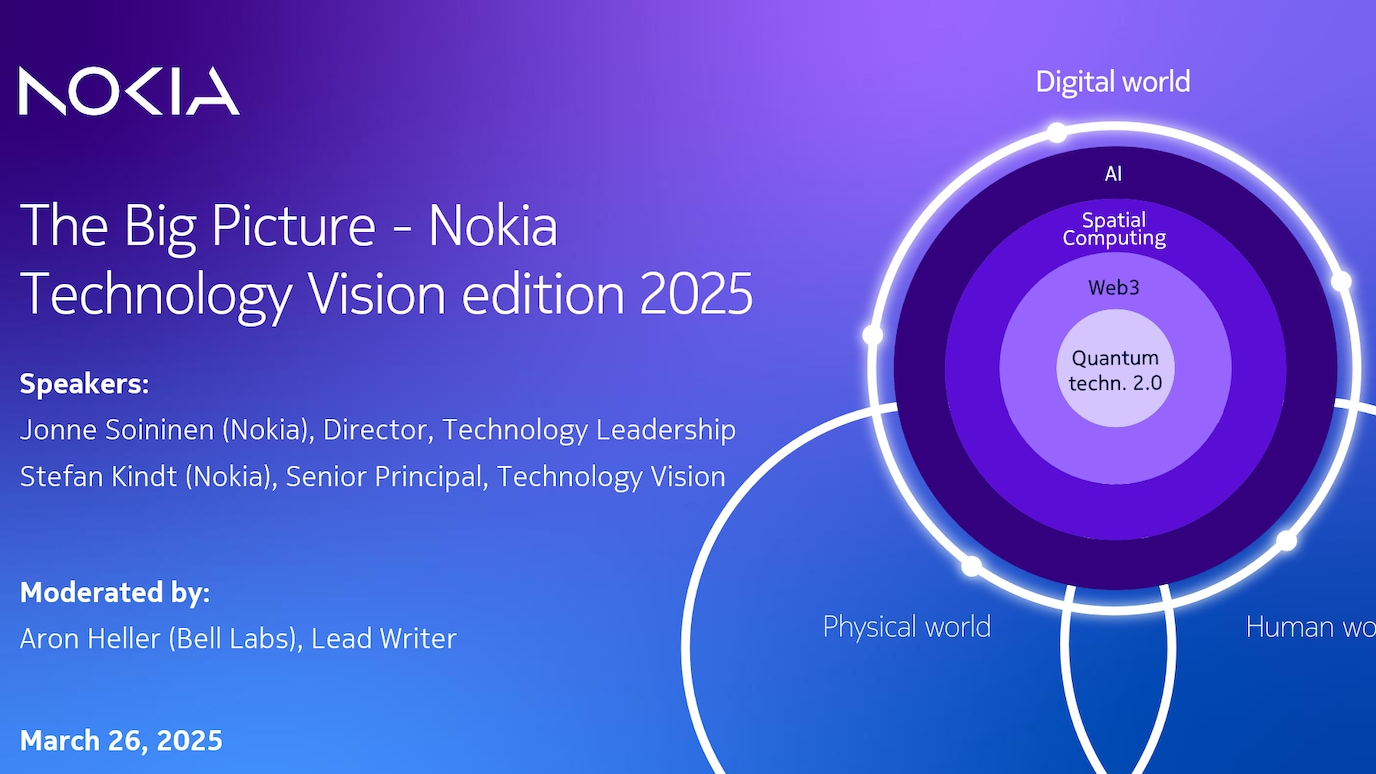Technology Vision: edition 2024
Digital acceleration toward the new quantum era
The era of the digital platform economy has revolutionized businesses, transforming how companies interact, innovate and operate, stimulating exponential growth in communication networks and related businesses. With new advances in technology evolution in areas like AI, spatial computing and Web3, we expect to see even more acceleration of digital services from now to 2035. Beyond 2035, quantum technologies hold the potential to disrupt many technology fields and revolutionize entire sectors, creating a massive expansion of technological capabilities that will continuously push the boundaries of innovation.
While these technological breakthroughs shape the future, they are unfolding within the context of a rapidly shifting global landscape.
Explore more watching our Nokia Technology Vision webinars
Macro trends reshaping the world: Adapting to global disruption
In a volatile global landscape, geopolitical, environmental, security and economic macrotrends are shaping the technology evolution. Geopolitical tensions are driving technology fragmentation with ripple effects that impact technology markets, technology regulation and technology adoption and heighten the demand for trusted technology and technology suppliers. Rising security concerns drive defense advancements, which might come at the expense of green and digital investments.
While climate change has been a business priority and information and communication technology (ICT) helps to lower the carbon footprint in many industries, there are also rising concerns about ICT emissions due to digitalization. In addition, stagnating consumer connectivity revenue is pushing companies to focus on network monetization for better returns.
Let’s take a closer look into the evolution of key technologies which play a vital role to enable, influence and facilitate communication services and related ecosystems.
Merging the digital, physical and human worlds
Advances in technology such as 5G, extended reality (XR), and digital twin technology have accelerated the digital evolution and created new opportunities that merge the digital, physical, and human worlds. These innovations enable seamless connectivity, smarter automation, and immersive experiences, creating a new world of integrated and transformative interactions. Even in developed markets, many industries are still in the early stages of commercial rollout of these innovations.
AI is set to transform the innovation landscape over the next decade
AI is poised to become the key driver of innovation in the coming decade, reshaping industries across the board. From devices to enabling platforms to customer services, AI will drive advancement in both hardware and software development, as well as the discovery and exploration of new materials, unlocking new possibilities in science and technology. Its impact will span every sector, driving unprecedented innovation.
AI integration, new capabilities and form factors are revolutionizing user interactions and experiences.
- Smartphones remain the central hub for connectivity.
- Natural language interaction and multi-modal capabilities enhance user engagement.
- Medical engineering is expanding device innovation.
- Advanced sensors monitor physical and emotional states, powered by low/no energy technology.
Integrating the digital, physical and human worlds creates richer, more meaningful connections.
- Spatial computing bridges digital and real-world environments.
- AI enhances understanding of both the physical and human worlds.
- Open, shareable 3D mapping and spatial anchors increases broad ecosystem development
- Digital twins evolve into complex cyber-physical entities.
- Web3 fosters decentralized trust and collaboration.
Services and solutions are adapting to meet new consumption patterns.
- The focus is shifting from quality of service to quality of personalized experiences.
- 3D audio creates immersive, customized soundscapes.
- Generative AI enables hyper-personalized media.
- Smart agents and humanoid robots are becoming increasingly common.
AI, spatial computing and Web3 will accelerate digital transformation
The integration of AI and digital technologies like spatial computing and Web3 is redefining how users interact with devices, services and the world around them. Device interaction will be revolutionized through natural language and multimodal interfaces. Advances in sensor technologies will enable systems to not only sense actions but also understand intent and emotional states, offering deeper personalization. We will see generative AI creating highly personalized experiences in sectors like media and entertainment, tailored precisely to individual preferences in real-time.
The smart world will feel more human
The spatial internet: A new paradigm in interaction
The spatial internet is a new paradigm in human-computer interaction that seamlessly integrates digital content—such as documents, videos, applications, and smart contracts—with physical locations and objects, creating an interactive, dynamic environment. In this advanced ecosystem, smart agents facilitate intent-based interactions, adding tangible value to real-world contexts by blending physical and digital experiences. The spatial internet relies on key enablers, such as spatial computing and spatial AI, which allow AI agents to understand and interact with the physical and human world both geometrically and semantically. 3D maps and spatial anchors, collaboratively maintained and shared, provide precise localization for real-time interactions, while Web3 technologies ensure decentralized value flows for computing, networking, and data management. Monetization opportunities arise from edge cloud services, networks, data, smart agents, and targeted digital advertising, forming the backbone of future business models in this hyper-connected environment.
Quality of personal experience in the integrated digital, physical and human world
Personal experiences can be significantly enhanced by integrating humans into network experiences, which creates opportunities for more personalized services and interactions. This integration enables real-time modifications to AI-generated media, games, training content and augmented data based on individual preferences and cognitive load. As a result, users experience higher levels of engagement, satisfaction, productivity and security. Key technology enablers for this personalized experience include body sensor networks, which offer advanced multi-modal sensing to measure cognitive load and physiological responses, and generative AI algorithms that facilitate personalized communications and interactions. Both consumer services and industrial and enterprise applications, such as enhancing productivity and safety for connected workers, can benefit from these service experiences. This opens the opportunities to serve as a new value driver for monetization.
Moving towards the quantum era as the end of Moore’s law approaches
As we approach the end of Moore’s law with traditional semiconductor technology, the need for disruptive technologies becomes increasingly urgent. Researchers are now looking beyond traditional paradigms to explore groundbreaking solutions that can propel technological progress forward. Quantum technologies, including quantum computing, quantum communications and quantum sensing, represent one highly promising avenue with the potential to usher in a new era—the new quantum era.

On the road to AI-native networks
Discover how AI is transforming networks, from AI-enabled to AI-native.

On the road to web3
Discover how world is transforming towards Web3, reimagining the Internet.
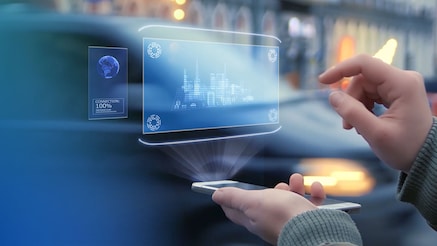
On the road to spatial computing
Discover how spatial computing merges digital and physical worlds, transforming our interactions with technology and reshaping how we experience reality.
Hardware and computing
Evolution in hardware and computing provides the bedrock to the advances described in our Technology Vision—providing needed progress in performance that supports each lead in device and application solution innovation.

Chipset evolution – end of Moore’s law:
- Computing growth driven by AI
- Density of transistor scaling slowing down below 3nm -> new compute paradigm needed
- Chiplet approach promising
- AI tools will expedite chip design

New materials & components:
- 2D layered materials (2DLMs) has a potential to enhance silicon technology via hybrid approaches
- Carbon nanotubes enabling device miniaturization

Quantum Technology 2.0 with disruptive potential:
- Quantum Compute
- For extreme complex calculation
- Post-Quantum Security
- Quantum Communication:
- Quantum Key Distribution (QKD, now-5y)
- Quantum repeater & internet (5-10y+)
- Quantum sensing with disruptive potential

Battery technology evolution:
- Driven by new materials and approaches (e.g. Sodium-ion)
- Reducing reliance on critical minerals like lithium and driving towards responsible use of rare earth resources
Software and data
Software continues to be the fundamental enabling technology, serving as an intangible and highly flexible material for implementing new ideas with AI, which will play a key role in driving change within the next decade.
AI/ML and data
AI and ML are the driving forces behind virtually all of the technological evolution in our vision—within devices, applications, networks and system solutions —and are accelerating research and innovation. Generative AI is transforming our relationship with information —an incredibly dynamic field characterized both by explosive innovation and uncertain regulation. While large language models (LLMs) are set to transform most functions where there is a need for a natural language interface, leaps expected in multimodal LLMs (MLLMs), using text, audio, image, and video intelligence, with smaller, on-device models are becoming more powerful. Data is a fundamental enabler for AI progress, but it is also a highly sensitive area from a privacy standpoint. Various techniques, including differential privacy, data fairness and synthetic data, are evolving to address these risks.
Quantum computing software
Quantum computing applications will be hybrid, with parts running efficiently on classical computers and specialized parts running on quantum computers. This will necessitate the provision of quantum computing as-a-Service on demand and on a pay-per-use basis. Therefore, new software engineering methods and tools are needed to deal with the specifics of QC applications, including building hybrid algorithms.
Security
Both quantum compute and AI are dual-use technologies that offer great benefits for an efficient cyber defense but, they also pose new challenges in protecting any network or data storage in general, as well as AI-based systems in particular. While AI makes it necessary to have comprehensive security strategies that consider technological, social, economic and legal aspects, the need for post-quantum cryptography demands immediate attention and needs to be addressed going-forward (store now, decrypt later).
ESG
Green software is an emerging discipline at the intersection of climate science, software design, electricity markets, hardware, and data center design to allow applications to run with lower CO2 emissions. The demand for ethical software is driven by the need for acceptance and trust in digital technology. Incorporating human factors in the engineering of next-generation software (including AI) solutions will become critical for future digitalization.
Advancing network technologies: evolutionary vs. disruptive
Network technology features and capabilities will continue to evolve and innovate, but, in light of the macrotrends and headwinds discussed earlier, in addition to the minimal growth expected in consumer connectivity revenues, we anticipate decreasing motivation in the future to productize individual new network features without clear understanding of the target market and potential return on investment. However, with the further acceleration in usage of digital services ahead of us, further demand in network performance and capabilities will be created to make these services work anywhere and anytime. Consequently, we can categorize the network technology evolution into evolutionary technologies, which improve current networks for scalability and efficiency, and disruptive technologies, which expand from existing network paradigms.
Evolutionary network technologies
- Edge cloud / Network-cloud continuum
- Cloud RAN & Open RAN evolution
- Extreme and distributed MIMO
- WiFi 7 -> WiFi 8
- 6G industrial automation
- Massive IoT
- Quantum-safe communications
- Spectrum sharing
- Multi-Fiber, multi-core and ultimately multi-mode optical long-haul
- Energy efficient wireless networks (10x capacity with -50% energy)
Disruptive network technologies
- AI-native networks
- NTN (radio and optical)
- Quantum repeaters / quantum internet communication
- Integrated sensing and communication
Additionally, as networks and their features evolve, we anticipate the emergence of various market drivers in dedicated markets. While in the consumer wide area network (WAN), the focus is on maximizing user experience and coverage at the lowest cost. Security and resiliency are highly needed in the industrial, government and defense sectors, as networks are seen as critical infrastructure. Furthermore, network-building paradigms are undergoing evolution. We anticipate a further evolution towards a network of networks concept, which encompasses solutions for neutral hosts, shared spectrum solutions and a continued push towards decentralized networks and compute.
Accelerating toward a new quantum era
Digital acceleration is evident across every technological advancement—from spatial computing to AI to the new quantum era. As the digital, physical and human worlds continue to merge and as quantum technologies begin to disrupt traditional models in the future, this acceleration will redefine industries, reshape personal experiences and continuously push the boundaries of technology.
Learn more
video
Nokia Technology Vision deep dive: on the road to Quantum 2.0 - breaking classical boundaries
video
Nokia Technology Vision deep dive: on the road to Web3, reimagining the Internet
video
Technology Vision deep dive: on the road to AI-native networks, the future of cognitive connections
video
Technology Vision deep dive: on the road to Spatial Computing - where digital blends with physical
video
The Big Picture - Nokia Technology Vision
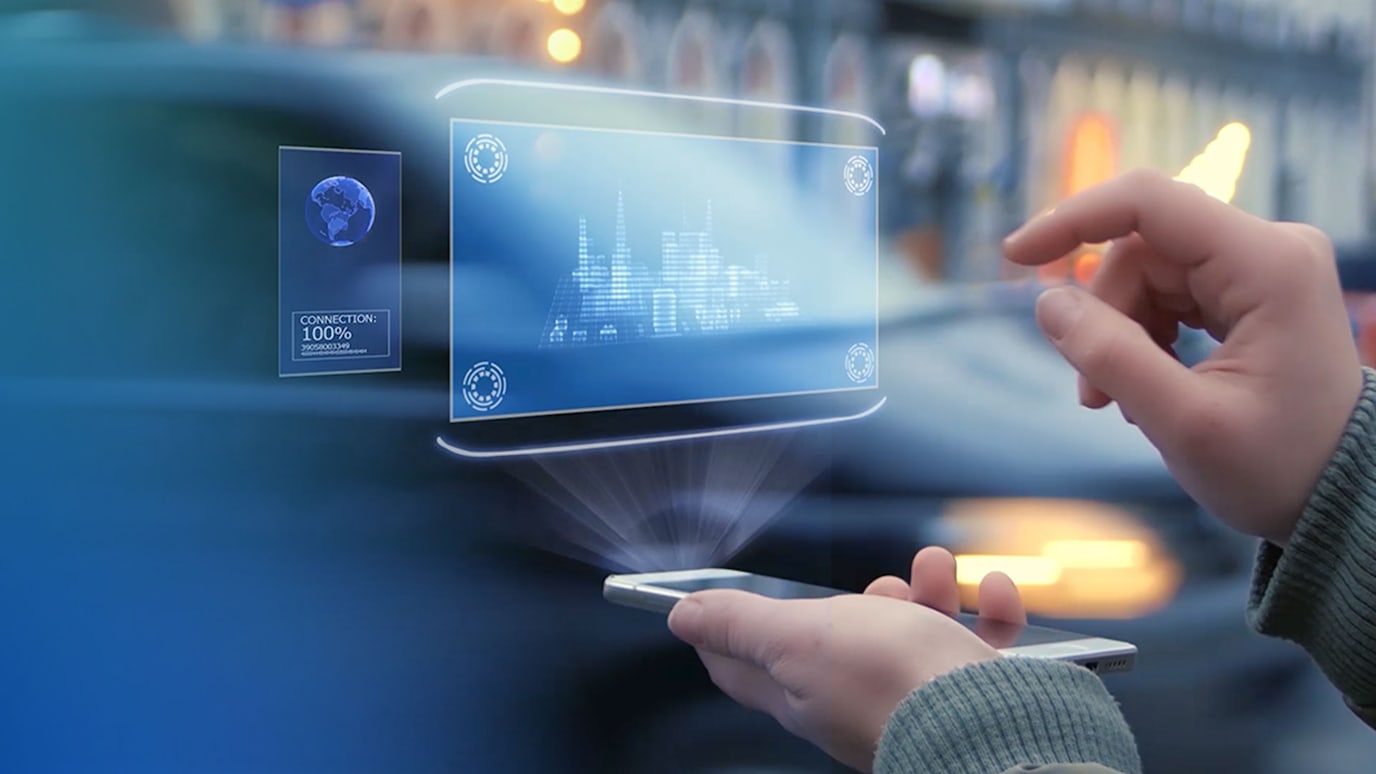
Page

Video

Topic












